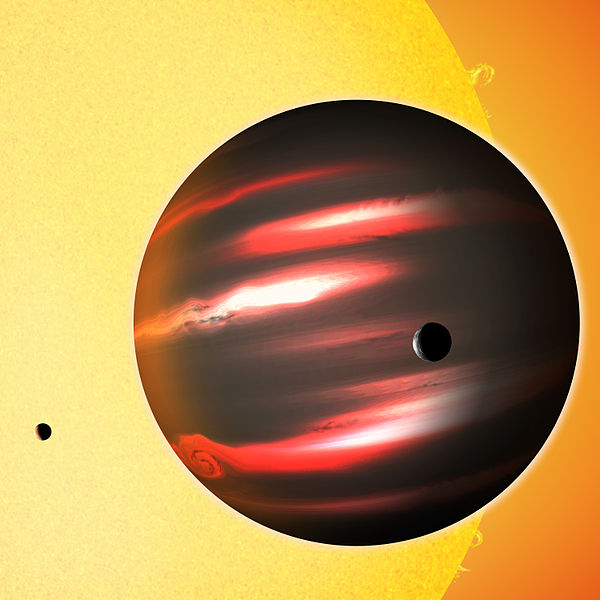Dark Knight: 3 Things You Should Know About This Blacker Than Coal Exoplanet
| KJ Belonio | | Jun 28, 2015 05:26 PM EDT |
(Photo : Wikimedia Commons/David A. Aguilar (CfA)) On June 28, a planet nicknamed “Dark Knight” was observed in a live public observation online. The darker than coal exoplanet was spotted by using the 1.52 meter infrared Carlos Sánchez Telescope, which is world’s largest infrared telescope. Despite being so dark, exoplanet TrES-2b or “Dark Knight” still absorbs light.
Do you ever want to catch a glimpse of a distant alien realm? Well, Saturday is a lucky day for all curious space enthusiasts as a live public observation of an elusive exoplanet can be watched online for the very first time.
Like Us on Facebook
According to the Slooh Community Observatory, a planet nicknamed "Dark Knight" was observed on June 28 as it crossed the face of its host star. Since it reflects so little light, it is considered the darkest planet in the universe.
"Dark Knight is the darkest exoplanet yet discovered, darker than coal or even black acrylic paint, reflecting just 1 percent of the light that falls on it," Slooh representatives wrote in a statement.
By using the 1.52 meter infrared Carlos Sánchez Telescope, which is the world's largest infrared telescope, the public was able to watch the transit of the impossibly black exoplanet "Dark Knight" as it passed in front of its sun. As per Space.com, the live feed started at 8 p.m. (EDT), while the transit began 28 minutes into the live broadcast. And its journey was completed in exactly 1 hour and 30 minutes.
So, what do we know about the "Dark Knight?" Aside from being beyond ridiculously dark, here are 3 interesting things to know about the planet.
1. The exoplanet "Dark Knight", called TrES-2b, is a Jupiter-sized planet that is orbiting its star at a distance of just 5 million kilometers. BBC News revealed the planet was named after it was first spotted by the Trans-Atlantic Exoplanet Survey in 2006. It is almost 750 light years away from the Earth and in the Draco constellation.
In addition, it also lies in the field of view of the Kepler space telescope, whose primary mission is to discover exoplanets using extremely sensitive brightness measurements as distant and elusive worlds pass in front of their host stars.
2. Discovered by researchers studying observations from California's Palomar Observatory and the Arizona's Lowell Observatory, TrES-2b is known as a "hot Jupiter." Yahoo! News reported the exoplanet is a gas giant that orbits extremely close to its host star. However, this planet doesn't blaze with a bright, fiery glow.
In addition, "Dark Knight" is a scorching planet at a temperature of 1,000 degrees Celsius and glows faintly red like a smoldering ember.
3. At twice the mass of Jupiter, the atmosphere of this blacker than coal exoplanet is a significant factor in what makes it so distinctively black. Unlike Jupiter and its light-reflecting ammonia clouds, Earth & Space learned that TrES-2b has an atmosphere of vaporized sodium, potassium, and titanium oxide, chemicals that not only completely fail to reflect light, but actively absorb it. However, that isn't enough to explain how it has an albedo so low it reflects less than 1 percent of all light that hits it.
Despite being so dark, exoplanet "Dark Knight" still absorbs light. And on why is the planet substantially darker than any substance found on Earth still remains unknown and a mystery.
TagsDark Knight, exoplanet, outer space, Universe, Science
©2015 Chinatopix All rights reserved. Do not reproduce without permission
EDITOR'S PICKS
-

Did the Trump administration just announce plans for a trade war with ‘hostile’ China and Russia?
-

US Senate passes Taiwan travel bill slammed by China
-

As Yan Sihong’s family grieves, here are other Chinese students who went missing abroad. Some have never been found
-

Beijing blasts Western critics who ‘smear China’ with the term sharp power
-

China Envoy Seeks to Defuse Tensions With U.S. as a Trade War Brews
-

Singapore's Deputy PM Provides Bitcoin Vote of Confidence Amid China's Blanket Bans
-

China warns investors over risks in overseas virtual currency trading
-

Chinese government most trustworthy: survey
-

Kashima Antlers On Course For Back-To-Back Titles
MOST POPULAR
LATEST NEWS
Zhou Yongkang: China's Former Security Chief Sentenced to Life in Prison

China's former Chief of the Ministry of Public Security, Zhou Yongkang, has been given a life sentence after he was found guilty of abusing his office, bribery and deliberately ... Full Article
TRENDING STORY

China Pork Prices Expected to Stabilize As The Supplies Recover

Elephone P9000 Smartphone is now on Sale on Amazon India

There's a Big Chance Cliffhangers Won't Still Be Resolved When Grey's Anatomy Season 13 Returns

Supreme Court Ruled on Samsung vs Apple Dispute for Patent Infringement

Microsoft Surface Pro 5 Rumors and Release Date: What is the Latest?










